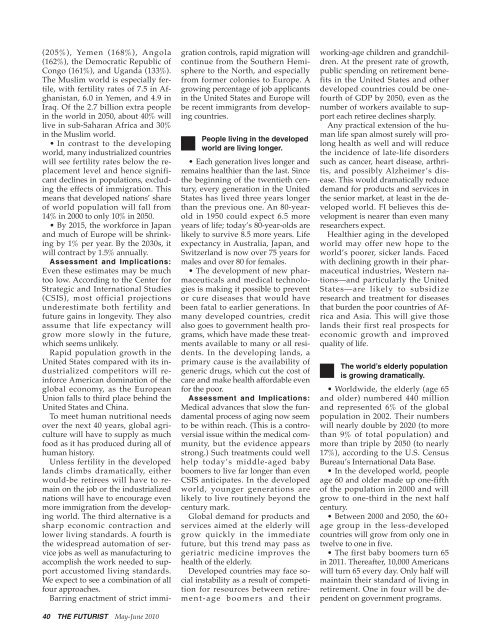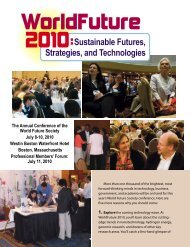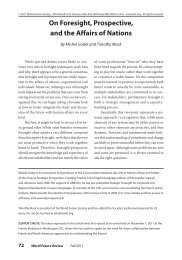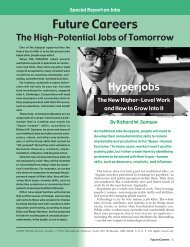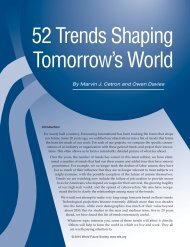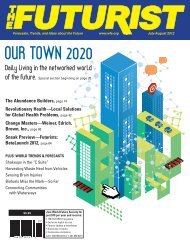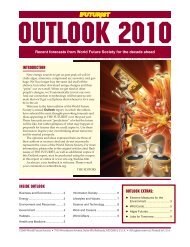Trends Shaping Tomorrow's - World Future Society
Trends Shaping Tomorrow's - World Future Society
Trends Shaping Tomorrow's - World Future Society
You also want an ePaper? Increase the reach of your titles
YUMPU automatically turns print PDFs into web optimized ePapers that Google loves.
(205%), Yemen (168%), Angola<br />
(162%), the Democratic Republic of<br />
Congo (161%), and Uganda (133%).<br />
The Muslim world is especially fertile,<br />
with fertility rates of 7.5 in Afghanistan,<br />
6.0 in Yemen, and 4.9 in<br />
Iraq. Of the 2.7 billion extra people<br />
in the world in 2050, about 40% will<br />
live in sub-Saharan Africa and 30%<br />
in the Muslim world.<br />
• In contrast to the developing<br />
world, many industrialized countries<br />
will see fertility rates below the replacement<br />
level and hence significant<br />
declines in populations, excluding<br />
the effects of immigration. This<br />
means that developed nations’ share<br />
of world population will fall from<br />
14% in 2000 to only 10% in 2050.<br />
• By 2015, the workforce in Japan<br />
and much of Europe will be shrinking<br />
by 1% per year. By the 2030s, it<br />
will contract by 1.5% annually.<br />
Assessment and Implications:<br />
Even these estimates may be much<br />
too low. According to the Center for<br />
Strategic and International Studies<br />
(CSIS), most official projections<br />
under estimate both fertility and<br />
future gains in longevity. They also<br />
assume that life expectancy will<br />
grow more slowly in the future,<br />
which seems unlikely.<br />
Rapid population growth in the<br />
United States compared with its industrialized<br />
competitors will reinforce<br />
American domination of the<br />
global economy, as the European<br />
Union falls to third place behind the<br />
United States and China.<br />
To meet human nutritional needs<br />
over the next 40 years, global agriculture<br />
will have to supply as much<br />
food as it has produced during all of<br />
human history.<br />
Unless fertility in the developed<br />
lands climbs dramatically, either<br />
would-be retirees will have to remain<br />
on the job or the industrialized<br />
nations will have to encourage even<br />
more immigration from the developing<br />
world. The third alternative is a<br />
sharp economic contraction and<br />
lower living standards. A fourth is<br />
the widespread automation of service<br />
jobs as well as manufacturing to<br />
accomplish the work needed to support<br />
accustomed living standards.<br />
We expect to see a combination of all<br />
four approaches.<br />
Barring enactment of strict immi-<br />
gration controls, rapid migration will<br />
continue from the Southern Hemisphere<br />
to the North, and especially<br />
from former colonies to Europe. A<br />
growing percentage of job applicants<br />
in the United States and Europe will<br />
be recent immigrants from developing<br />
countries.<br />
■<br />
People living in the developed<br />
world are living longer.<br />
• Each generation lives longer and<br />
remains healthier than the last. Since<br />
the beginning of the twentieth century,<br />
every generation in the United<br />
States has lived three years longer<br />
than the previous one. An 80-yearold<br />
in 1950 could expect 6.5 more<br />
years of life; today’s 80-year-olds are<br />
likely to survive 8.5 more years. Life<br />
expectancy in Australia, Japan, and<br />
Switzerland is now over 75 years for<br />
males and over 80 for females.<br />
• The development of new pharmaceuticals<br />
and medical technologies<br />
is making it possible to prevent<br />
or cure diseases that would have<br />
been fatal to earlier generations. In<br />
many developed countries, credit<br />
also goes to government health programs,<br />
which have made these treatments<br />
available to many or all residents.<br />
In the developing lands, a<br />
primary cause is the availability of<br />
generic drugs, which cut the cost of<br />
care and make health affordable even<br />
for the poor.<br />
Assessment and Implications:<br />
Medical advances that slow the fundamental<br />
process of aging now seem<br />
to be within reach. (This is a controversial<br />
issue within the medical community,<br />
but the evidence appears<br />
strong.) Such treatments could well<br />
help today’s middle-aged baby<br />
boomers to live far longer than even<br />
CSIS anticipates. In the developed<br />
world, younger generations are<br />
likely to live routinely beyond the<br />
century mark.<br />
Global demand for products and<br />
services aimed at the elderly will<br />
grow quickly in the immediate<br />
future, but this trend may pass as<br />
ger iatric medicine improves the<br />
health of the elderly.<br />
Developed countries may face social<br />
instability as a result of competition<br />
for resources between retirement-age<br />
boomers and their<br />
working-age children and grandchildren.<br />
At the present rate of growth,<br />
public spending on retirement benefits<br />
in the United States and other<br />
developed countries could be onefourth<br />
of GDP by 2050, even as the<br />
number of workers available to support<br />
each retiree declines sharply.<br />
Any practical extension of the human<br />
life span almost surely will prolong<br />
health as well and will reduce<br />
the incidence of late-life disorders<br />
such as cancer, heart disease, arthritis,<br />
and possibly Alzheimer’s disease.<br />
This would dramatically reduce<br />
demand for products and services in<br />
the senior market, at least in the developed<br />
world. FI believes this development<br />
is nearer than even many<br />
researchers expect.<br />
Healthier aging in the developed<br />
world may offer new hope to the<br />
world’s poorer, sicker lands. Faced<br />
with declining growth in their pharmaceutical<br />
industries, Western nations—and<br />
particularly the United<br />
States—are likely to subsidize<br />
research and treatment for diseases<br />
that burden the poor countries of Africa<br />
and Asia. This will give those<br />
lands their first real prospects for<br />
economic growth and improved<br />
quality of life.<br />
■<br />
The world’s elderly population<br />
is growing dramatically.<br />
• <strong>World</strong>wide, the elderly (age 65<br />
and older) numbered 440 million<br />
and represented 6% of the global<br />
population in 2002. Their numbers<br />
will nearly double by 2020 (to more<br />
than 9% of total population) and<br />
more than triple by 2050 (to nearly<br />
17%), according to the U.S. Census<br />
Bureau’s International Data Base.<br />
• In the developed world, people<br />
age 60 and older made up one-fifth<br />
of the population in 2000 and will<br />
grow to one-third in the next half<br />
century.<br />
• Between 2000 and 2050, the 60+<br />
age group in the less-developed<br />
countries will grow from only one in<br />
twelve to one in five.<br />
• The first baby boomers turn 65<br />
in 2011. Thereafter, 10,000 Americans<br />
will turn 65 every day. Only half will<br />
maintain their standard of living in<br />
retirement. One in four will be dependent<br />
on government programs.<br />
40 THE FUTURIST May-June 2010


